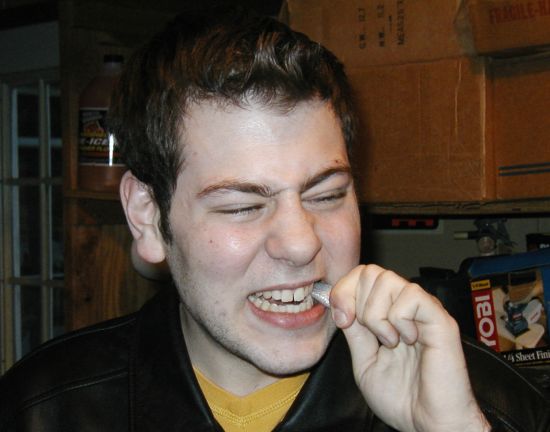(or, The LGLF Official Guide to Stefan Making).
by Langley, A.S. and The Fred, B.S., M.S., Ph.D., MD, Ed.D
Many people have come up to us while at wars and asked us some interesting questions about the way we make our Stefans. We've tried to answer these questions as best as we can, but now we've decided to take our process and post it on the web for all to see. This is really the way we do it -- we've kept no secrets to ourselves. If you think our method sucks, you're welcome to make your darts any way you want, but we think that our process consistently makes Stefans that shoot straight and far... just like your mom.
In this article, we are going to address the production of mega Stefans, but nearly all of the following steps can be applied to 1/2" Foam Backer Rod (FBR) as well as for the 5/8" FBR used for megas.

Step 1. Purchase Your Shit.
The first step to making kickass Stefans is to buy, and buy wisely. We've learned through trial and error what kind of foam backer rod NOT to buy (especially that black crap from LogHelp.com). There are many brands of FBR available, and what works well with us here in New Jersey might not be useful or even available where you may be, so you won't get a recommendation from us. What you should do is try different brands of FBR and use the brand that works best with the 1/2" PVC available to you. Eventually, you will come across something that works well and want to stick with it. (Note: Many people, including the hourly-paid peons who work at Home Depot, don't know what FBR is. It is useful in these situations to ask for directions to the Foam Weather Stripping section, and as another note, FBR is also sometimes known as "Caulk Saver.")
As you probably know, each stefan must be glued with a small weight inside of it. For mega Stefans, we use Size 7 fishing weights, or "sinkers" (available at your local sporting goods store's fishing supplies section). For minis, we use Size BB fishing weights. We can only procure them in 30 ct. sizes, but you may be able to buy them in bigger packages.
You will also need to purchase at least one glue gun, but we prefer to use two for different uses. The glue gun should be of either a high- or variable-temperature variety (they are not expensive to buy if you go to a local hardware or crafts store). We use a hacksaw for cutting our templates and FBR, and to use the saw properly we also have a miter box. All of these things will be explained further in detail as our lesson progresses.
Step 2. Foam Preparation.
Okay, you're back from the hardware store and you're eager and ready to get started. If you want darts that resemble the shape of curly fries, start now. If you want to make them straight, you're going to have to leave them outside for a while.
We generally straighten our stefans out on the groove on the side of a metal ladder for a good two or three weeks. As the FBR is naturally curled up in a roll, we have to tape each end down to the ladder side in order to make sure that the foam straightens the way we want it to. If you're strapped for time, after taping the FBR to the ladder (or whatever device you've ingeniously chosen to use), you can quickly apply a blowdryer on High setting to the foam to straighten it quicker. Using quick side-to-side motions, in order to keep the foam from melting under the heat, you should be able to soften the foam. Leave it out on your straightening device to cool, and the foam will be less likey to curl back up on it's own.
Step 3. Cutting Stefans.
After your FBR is straightened to your taste, you will proceed to cutting your stefans. In order to get a nice straight cut, you will want to cut your stefans through a PVC template. You will start by cutting a length of PVC approximately 1/2" longer than you want your stefan to be, using your saw and miter box. We make our stefans aproximately 2" long, and therefore make our templates 2 1/2" long. After this, de-burr the PVC using a rasp, Dremel, sandpaper, or even your fingernail.
Next, determine how long you want your stefans to be (once again, this is a matter of taste, but our stefans are usually around 2" - 2 1/4" in length) and make a mark that distance away from one end of your PVC using pencil, pen, or the blood of a virgin. Using the miter box and hacksaw, cut PARTIALLY through the PVC at this mark, cutting through until the saw has almost severed the entire inside of the PVC. You can test this by holding the PVC up to a light with the hacksaw inside of it. Optimally, you should only see a small point of light through the saw-PVC gap. Once again, de-burr the inside of the PVC. We've found that the best way to do this is to wrap a piece of sandpaper around a screwdriver and rub it around the inside. (See our upcoming article "How to Please a Woman: The LGLF Way" for more insight as to this procedure.)
Now, take your straightened FBR and insert it into the template (it is best to twist the template, not the FBR, in order to minimize tangling of the foam). Nip a small amount of foam from the template, so that your first stefan is uniform on both ends. Make sure the foam is inserted in the proper side of the template (that is, the side opposite the length you have previously marked off with your virgin), and the lead end of it is flush with the other end. You need only swipe your hacksaw lightly to cut your stefans; after a little while, you'll get the hang of the proper amount of pressure to use. Over time, your template will begin to wear down with use, no matter how careful you are with your cutting. When this happens, simply start again with a new template (this means it's a good idea to make more than one template at the very beginning). Use your first template to mark off the lengths for your other templates to ensure uniformity.
Step 4. Drill Calibration.
There are many different ways to drill holes into your stefans. Some like to twist a drinking straw into one end of the stefan and then remove the loose inside piece with pliers; some prefer to use a soldering iron. The LGLF uses a drill press to make our holes, and our way is better, bitch. We've found that the proper drill bit to use for our mega Stefans is 7/32" (although for practicality's sake, 1/4" will work just as well). To hold the stefans while drilling, you're going to want a small length of PVC that has a coupling attached to it. The coupling provides for stability.
Now we calibrate our drill press. Assuming that the stefans you have cut are approximately 2" in length, you will want the hole in your stefan to be about 1 1/2", leaving 1/2" undrilled. To calibrate the drill press, you will want to lower the drill bit as far down as it will go and hold it there, while adjusting the base. Keeping in mind that you will be putting the undrilled stefans into the dart-holder so that they are flush with the top, move the base so that only about 3/8" to 1/2" of stefan will not be drilled. Also keep in mind that later on you will be making a hole in the tip of the dart for the weight, and if you make the initial hole too deep, they will meet in the middle of the dart. This is unacceptable. Note: Some drills have a nifty doodad wich allows you to fine tune how far down the drill can be lowered. If you have one, this is the ideal time to use it.
Step 5. Drilling.
Proceed to drill all your un-drilled stefans by twisting the dart into the dart holder so that the top of the dart is flush with the top of the holder, and lower the drill untill it can drill no further. Pull any loose strings of foam out of the hole, and put the drilled dart in a container to be glued later on. Be sure to drill as close to the center of the dart as possible; this is crucial to make sure that your darts have maximum uniformity.
Step 6. Glue-on-her-dart.com
Before you begin to glue your darts, cut several short lengths of PVC so they are a little longer than your dart length using the hack saw and miter box. Ten or twelve should be enough. Now you can begin to glue your darts.
First, you want to prepare your dart for glueing. Do this by twisting the dart into one of your PVC holders and poking a small hole into the tip of the dart. We do this using our smaller glue gun. Make sure the hole is deep enough that the weight does not protrude from the hole; if you don't believe this is important, get hit with one of the darts you made this way. It will HURT. After you have done this three or four times, make sure you swap the melted foam off the tip of the glue gun.
Now you may cover the weight with a small glob of glue. The optimal size of the glob will varry depending on the foam, glue gun, and glue. Keep in mind that the glob will flatten out and spread over the dart. Ideally, you want the weight and the tip of the dart almost completly covered with glue. However, if you insert the dart into PVC, you don't want any glue to touch the inside of the PVC, so be sure not to put so much glue on the dart that it drips over the sides. If a bubble forms in the glue, poke it with the tip of the glue gun to pop it.
Let the dart sit in it's holder and dry and move on to the next dart. By the time you run out of holders, the first dart you glued should be dry, and you can start this process over again.
Conclusion
If you've followed these steps religiously (and by this, we really mean that you've built two life-size religious shrines of Langley and The Fred), you will notice that your latest batch of stefans is more durable, more uniform, and consistently get more range than any darts you have encountered before. On the other hand, if you notice any flaws or errata in the article, please feel free to email us at lawngnomeliberationfront@yahoo.com. If we've messed up, we'll be glad to fix it; if we didn't mess up and you're a stupid asshole, we'll be glad to show up at your front door and kick your ass in front of your little sister.
Best of luck to you,
Langley and The Fred
© February 2004
Edited by Langley, 03 January 2012 - 04:38 PM.



 This topic is locked
This topic is locked

















